
As the Zika virus, also known as Zika or ZIKV, and its effects have been a main topic in the news during the summer of 2016, many wonder how this disease may affect them. However, this disease has not been studied for a long period of time and there are still some unknowns regarding its effects on humans. According to Lupton (2016), the disease is transmitted through mosquito bites from the aedes aegypti mosquito, but the exact number of days for the incubation of ZIKV is inconclusive. Based on various sources, the incubation period may range anywhere from 3 to 12 days. Also, the disease is asymptomatic in a majority of cases as “approximately 1 in 5 people infected with ZIKV show symptoms, these include acute onset fever, maculopapular rash, arthralgia, conjunctivitis, headache and eye pain” (Lupton, 2016, p. 200). Lupton (2016) also stated that the countries that currently have the largest number of cases of ZIKV also have cases of chikungunya and dengue fever, which can look similar to the symptoms of ZIKV. As a result, it is important to “conduct laboratory testing to avoid a misdiagnosis” (p. 201) as using non-steroidal anti-inflammatory drugs to relieve the symptoms can cause hemorrhaging, especially if dengue is the condition one has. It is important to note that Lupton (2016) also stated that women at any stage of pregnancy should avoid travelling to countries affected with ZIKV as this may increase the possibility of giving birth to babies with neonatal abnormalities should they become infected. This article supports many of the claims of the video clips on the Zika virus, such as how it is transmitted, the symptoms, and the fact that women at any stage of pregnancy, not just the third trimester, should be careful about travelling to the affected countries. None of the media clips spoke about Zika being possibly mistaken for another disease and that testing should be done to rule those out.
The research conducted by Marques Salge, Corrêa Castral, Cordeiro de Sousa, Godoi Souza, Minamisava, & Brunini de Souza (2016), stated that “only 18% of human infections with the Zika virus result in clinical manifestations. Among them, the most common are maculopapular rash, low fever, arthralgia, myalgia, and headache” (p. 9). When pregnancy is accompanied by a rash it may be a sign that microcephaly will manifest in the newborn, although this is not in all cases and a rash does not indicate the Zika virus. The transmission of the disease, aside from a bite from the aedes aegypti mosquito, may also occur sexually or other body fluids such as saliva and urine. Marques Salgue et al (2016) also stated that to date, no other conditions in utero is associated with the Zika virus other than microcephaly. However, microcephaly and Zika only have an association, it is not conclusive that this virus causes microcephaly in newborns when the mother is infected. This article also speaks about the same topics such as the clinical manifestation of the disease and how it is transmitted. The media clips I chose were conclusive in saying that Zika caused microcephaly, but this article states that there is an association of the virus with microcephaly, but it is not conclusive that this is the cause.
In Sutton and Hudson’s (2016) article, they stated that the Zika Virus (ZIKV) is associated with congenital birth defects and infection is caused by the aedes mosquito. The World Health Organization (WHO) has been following up on ZIKV and its spread into 46 countries and territories. The signs and symptoms associated are “low grade fever, swelling in joints of the hands and feet, a transient rash that spreads from the face to the body, conjunctivitis resembling pink eye, including general symptoms such as myalgia, and head- aches” (Sutton & Hudson, 2016, p. 36). In an effort to prevent contracting this disease, people are advised to have protected sex, apply “insect repellents containing DEET, wear clothes that cover ex- posed skin, stay in screened areas and sleep under mosquito nets” (Sutton & Hudson, 2016, p.38). Based on the video clips, one may not know that Zika has been monitored since 2007 by the WHO and viewers may think that this is a fairly new disease. Nevertheless, it is in agreement with the clips that mosquitoes and sex are the most common ways that this disease is transmitted.
Below are video clips that discuss the Zika virus, how it manifests itself and how to prevent it.
References
Lupton, K. (2016). Zika virus disease: a public health emergency of international concern. British Journal Of Nursing, 25(4), 198-202.
Marques Salge, A. K., Corrêa Castral, T., Cordeiro de Sousa, M., Godoi Souza, R. R., Minamisava, R., & Brunini de Souza, S. M. (2016). Zika virus infection during pregnancy and microcephaly in newborns: an integrative literature review. Revista Eletronica De Enfermagem, 181-14. doi:10.5216/ree.v18.39888
Sutton, K. L., & Hudson, M. P. (2016). ZIKA: A Mosquito-borne Emerging Virus. Journal Of Continuing Education Topics & Issues, 18(2), 36-40.

